Today we have our review of the Netgear ProSAFE XS708T 10Gbase-T switch. We recently covered the switch in the new Netgear 10Gbase-T switch launch earlier this year. We also reviewed the previous generation Netgear ProSAFE XS712T which we still use on a daily basis. For many STH readers, this is the 10Gbase-T switch you have been waiting for. It is priced at under $1000. Perhaps as importantly, or more importantly to many, this is the first switch we have seen with more than four 10Gbase-T ports that is quiet enough for SMB office or home use. In a briefing with the company, Netgear told us this was due to previous feedback and new generations of switch silicon. Today we have the results of those efforts in an 8-port switch.
Netgear ProSAFE XS708T Overview
The Netgear ProSAFE XS708T is a fairly simple switch in terms of a physical layout. It is a short depth chassis that can be mounted easily via rack ears or be used as a desktop unit.
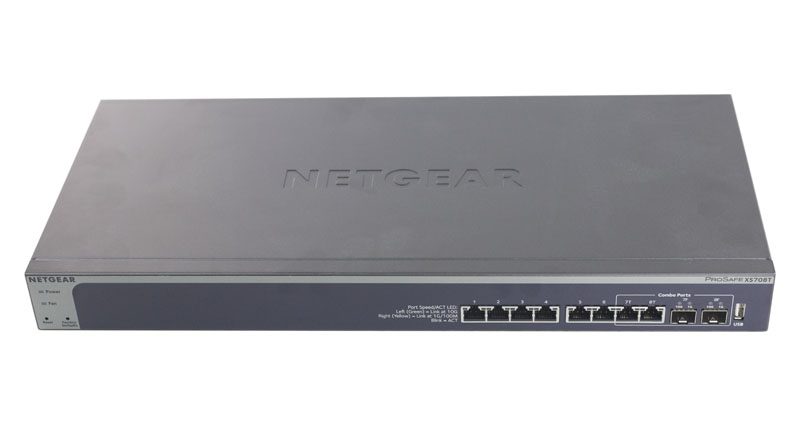
There are a total of eight 10Gbase-T ports with ports 7 and 8 supporting either 10Gbase-T or SFP+ networking. Each port can be used in either mode. This is extremely handy when one has a 1GbE switch to uplink via a common SFP+ connection.
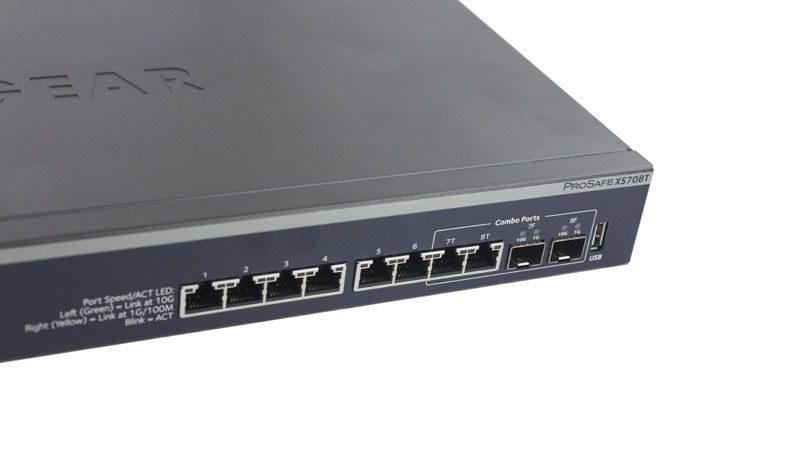
On the front panel we also find status LEDs and reset buttons. There is a USB port that can be used for firmware upgrades as well.
The rear of the unit has MAC address information as well as power information. Although less aesthetically pleasing, we would like to have seen the MAC address sticker moved to the front of the unit so it is easier to read in racks.
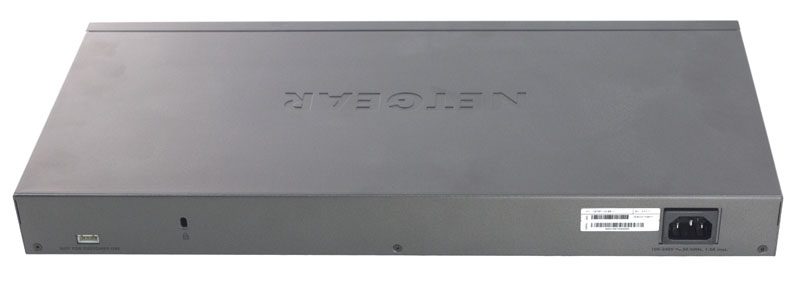
The switch also has a Kensington lock port. With a $900-1000 switch being used in SMB settings, it may be wise to invest $30 on a lock to deter theft.
Inside the unit we see the basic workings of the switch. There are large heatsinks on the switch chips and PHYs. There is a lot of room in this switch.
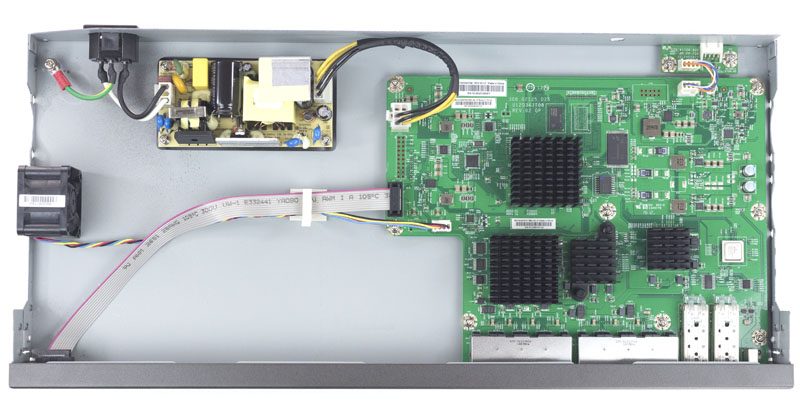
One area we wanted to focus on is the cooling. As one will see from our power and noise tests, this generation of Netgear 10Gbase-T switches run much cooler than previous versions. The fan appears to be a 4-pin PWM version. Our fan was running mostly around 3200rpm at a 20-24% duty cycle. That kept noise to an absolute minimum.
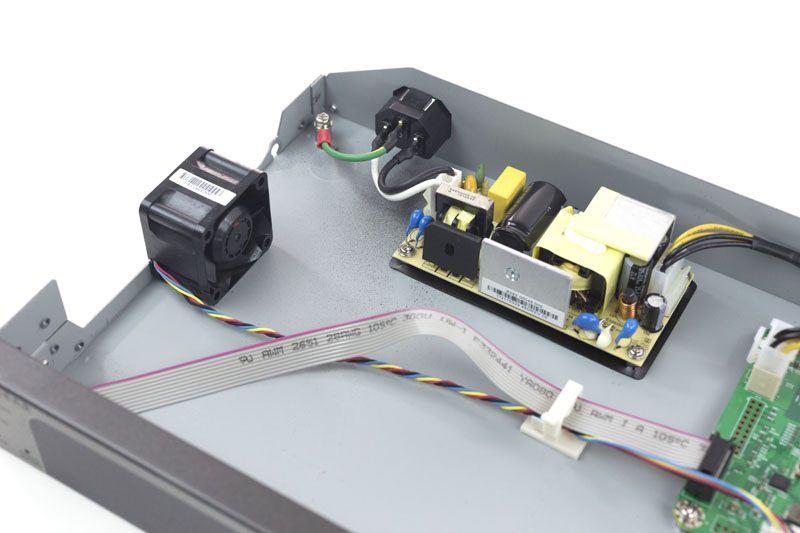
With that overview, it is time to see the exciting portion of the review: numbers. The hardware and management combination that Netgear has put together is what we have been waiting for in the SMB/ SOHO 10Gbase-T space.
Test Configuration
For this test we needed to handle 80gbps which is very easy to accomplish in our lab. We hooked up the two SFP+ combo ports to our Quanta T3048-LY8 switch and the remaining ten 10Gbase-T ports to our Quanta T3048-LY9 and dual Intel Xeon E5-2698 V3 KVM hosts we were using for a small Openstack demo. Each of the Quanta switches have a (much) higher switching capacity and were linked to our 40GbE NVMe storage arrays. In one of our lab test racks, we were able to install the Netgear XS708T using rack ears. No rails required.

Netgear XS708T Power Consumption, Noise and Performance
We have a 24-port Dell PowerConnect 8132 in the Fremont, California data center and a 48-port 10Gbase-T (plus 6 port 40GbE) Quanta T3048-LY9 in our Sunnyvale, California data center. These are higher-end switches that use more than 100w at idle. In contrast, the Netgear XS708T idles at around 16W (with short 3M cables). Under moderate use (VMs and hypervisors) we let the switch sit in our Sunnyvale California facility for a few weeks attached to a ZFS storage node and a few KVM hypervisors and a samba data store for a few Windows servers.
- Idle: 15.8W
- Maximum observed: 29.1W
In terms of comparison, the previous generation Netgear XS712T (12 port) we reviewed idled in the 49-50w range. Although with 4 less ports, that is less than a third of the idle power consumption.
To measure noise output we used our Extech 407764 NIST calibrated sound meter. In the datacenter, this is of little concern however for SMB offices and home labs, noise can be a factor. We observed noise in the 23-30dba range during our testing. That is a complete game changer. Previous generations we have tested were well over 50dba. As a result, this is the first 10Gbase-T switch we can recommend for inhabited areas. It is not silent, but it is quiet enough that it is serviceable outside of a well insulated equipment cabinet.
Performance is what we would expect from such a switch:
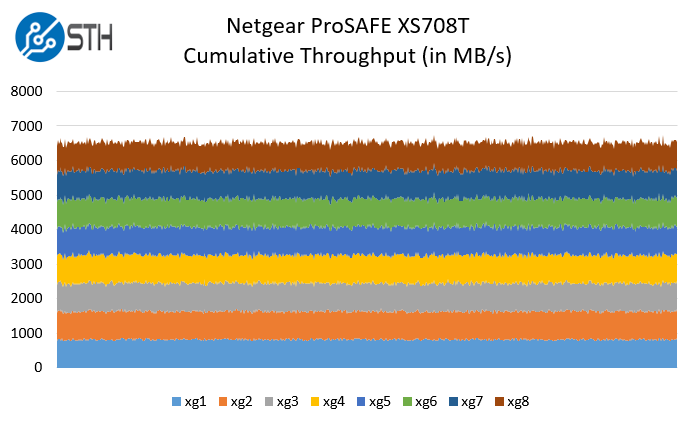
We were able to saturate all eight links. We also performed the same iperf3 testing using SFP+ DAC and optics in xg7 and xg8 and saw similar performance.
Netgear ProSAFE XS708T Management
While users studying for their CCNA exam will likely want a Cisco switch, in the 8-port switch tier many users do not want to learn a CLI. Frankly, if you need 48+ 10Gbase-T ports, you are better off buying a larger switch than trying to manage many of these lower port count Netgear switches. As a result, a GUI is the primary management interface. I suspect that the XS708T positioning is in the SMB sector so having a simple to navigate yet powerful web GUI is a must-have feature. Netgear delivers on this and it is exceedingly easy to configure VLANs, QoS and other features as part of the “Smart Managed” line.

Unlike previous versions we found support for up to 4093 VLANs and event he ability to perform some basic routing as a L2+ switch.
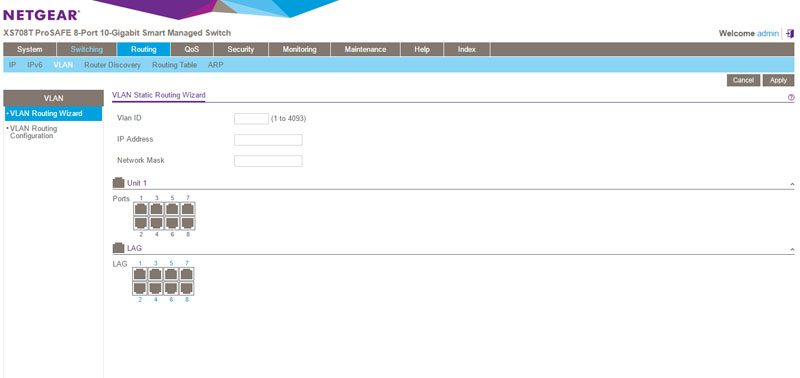
We also confirmed though out setup that STP was available and working.
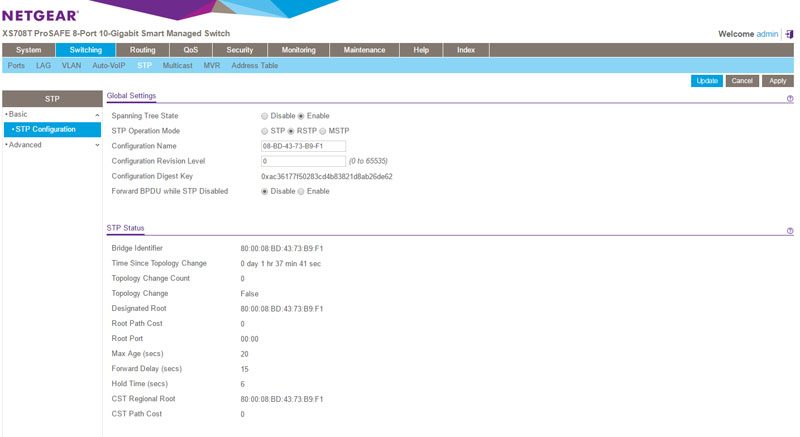
There are a lot of features in the Netgear ProSAFE XS708T switch, but they were easy to find and manage via the web interface. For an SMB or high-end home administrator, the web interface is excellent.
Conclusion
The Netgear ProSAFE XS708T is the first 10Gbase-T switch I would put in a SMB office or a home without reservation. STH has thousands of members experimenting with Intel Xeon D machines that have dual 10Gbase-T NICs. This is the first switch that can be used as a switch to provide high-speed networking to low power server nodes that act as a hyper-convered cluster with storage and virtual machines. The low power consumption and noise address the two main drawbacks with the previous generation of Netgear’s switches thanks to new chip sets becoming available. The bottom line on this: it is the best low port count 10Gbase-T switch we have seen to date and is a watershed product in terms of SMB/ SOHO networking.

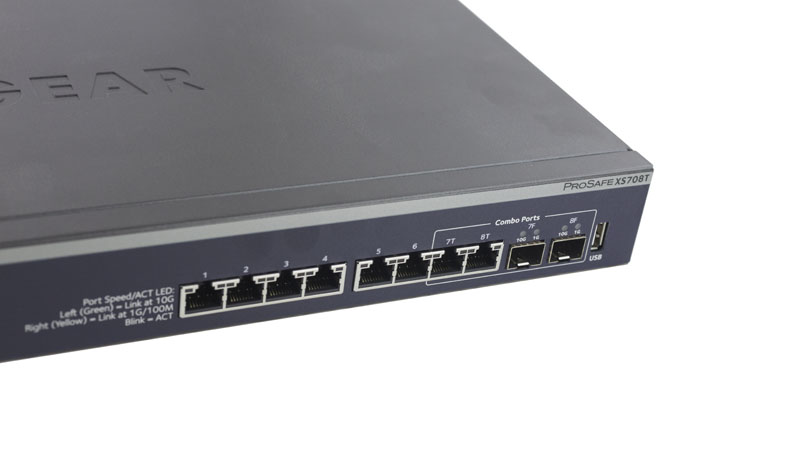



Do you use spell check?
“short depth chassis that cab”
“basic workings of the swithc”
Is the web interface for configuration a new thing? A few of the Amazon reviews (no more than a month old) for this device state that the config is through a Windows app that require Adobe Air.
The switch is new and this is the primary configuration tool we used.
Amazon lumps reviews together. Remember anything older than May 2016 is for a different product.
Thanks. I think you are right. The reviews are from 18 and 24th June, but they may both be for the XS708E (E ending) which is the web configured version. My bad. Thanks again.
Looks like the XS708T even has SNMP. cool.
This switch: 980 USD
Mikrotik CRS210-8G-2S+IN: 230 USD
You’re welcome.
Mark – that Mikrotik is a 1Gbase-T model not a 10Gbase-T model like the switch reviewed.
Nice review and sweet switch! I would love to have SFP+ version though, as SFP+ NICs are much cheaper than 10GBase-T
Do you have an overview article about faster than 1g switches?
I think you could reach a new audience (people like me), who might buy a xeon d system (like the tinker try system), with its 10 gig capability, and would benefit from a getting started/ survey of the eco-system, including switches. A kind of home server getting started. Someone who has already had 1 gig switches in their home, who has built computers before, who has installed os’, but maybe not done much with hypervisers. You could describe: what 10g switch you want, describe the two 10g variants, the right version of vmware, suggest nvram or whatever to go in that server so you can run some shared storage across os’. There’s a lot you can do with a xeon d with 8 or 16 cores. I had another idea about this area, a system in this area has so much ram and cpu (and 10g eth), it’s something that might last a long time, 5+ years.
Ubiquiti 10G 16-Port Managed Aggregation Switch ES-16-XG
12 SFP+ ports and four RJ45 10GBASE-T ports ,
https://www.ubnt.com/edgemax/edgeswitch-16-xg/
4900 CNY (~749 USD)
The Ubiquiti switch has zero availability at this point. We have heard maybe late September early October. Ubiquiti paper launched with no product.
Does anyone know which main chipset in used in the Netgear XS708T?
http://www.buffalotech.com/products/10-gigabit-ethernet-switch
can you review this one?
costs ~500 francs here in switzerland… about 500 euros
Carlos, we will see what we can do.
Fan makes an annoying buzzing sound. Can anyone suggest a quieter replacement fan?
OK, back to answer my own question. If you want to mod the switch to make it silent here’s your best bet!
Bear in mind that this will void your warranty however.
Noctua NF-A4x20 PWM http://noctua.at/en/products/fan/nf-a4x20-pwm is a perfect, and silent replacement for the stock fan.
Hi Patrick
Could you write a type of power supply – Netgear xs712&716.
Thank you.